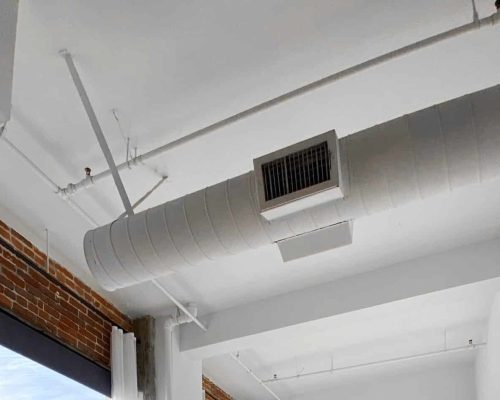CFM is an important concept to understand when discussing HVAC systems. In the home comfort industry, CFM is a measurement of how much air moves through an area each minute.
By knowing what CFM is and understanding CFM measurements for your furnace and AC unit, you can maintain your HVAC system better and prolong its lifespan.
What is CFM in HVAC and why is it good to know? The CFM measurement directly affects your system’s heating and cooling capacity. So for homeowners, especially those wanting to upgrade their system, learning about CFM can better inform purchasing decisions.
If you’re interested in learning more about CFM, just get in touch with our staff at River Valley Air Conditioning after checking out this article.
What is CFM in HVAC, and What Role Does it Play?
One of the most commonly asked questions we get when homeowners are shopping for a new system, is “what does CFM stand for in HVAC systems?”
CFM (cubic feet per minute) is a metric that determines how much air is pushed by the system to heat, cool, or ventilate a certain area. This measurement is helpful when determining which size and power output is needed for a space.
A rule of thumb is that spaces need 1 CFM per square foot. So, for example, if you have a 10-foot by 12-foot bathroom, (120 square feet), you will need a fan with 120 CFM.
HVAC experts use CFM calculations to calculate the right amount of airflow for a particular space while also considering factors like room size, how it’s used, and the desired temperature.
There are several things that can affect a unit’s CFM measurement, including the system’s capacity, the air filters, and the shape and size of the ductwork. For HVAC systems to operate efficiently while also maintaining comfortable temperatures and air quality, your AC unit or furnace needs a good CFM measurement.
How CFM Affects HVAC Efficiency and Functionality

So, what does CFM mean in HVAC and how does it affect efficiency? The right level of ventilation in your home is important for a lot more than heating and cooling.
Too much or too little airflow, can cause several issues, including excess dust and mold growth. Fortunately, calculating your home’s CFM and matching it to a suitable HVAC system can solve this issue and prevent others.
Proper Heating and Cooling
Consider how your system warms or cools the air. CFM is one of the key measurements that helps provide the appropriate amount of cool or warm air to keep your space at a comfortable temperature.
If the CFM is low, a system’s capacity for cooling or heating may not be enough for the space. This can result in uncomfortable temperatures throughout your home. On the other hand, if the measurement is too high, it will use too much energy and cause the system to wear down earlier than expected.
HVAC Systems and Their Air Quality
When learning what is a CFM in an HVAC system, many homeowners just look at the heating and cooling, but not necessarily the potential for improvement in air quality. Proper CFM guarantees proper airflow and air exchange, both of which are necessary if you’re looking to maintain indoor air quality.
With better airflow, homeowners are less likely to encounter contaminants, mold spores and excess dust.
Improved Energy Efficiency
CFM can actually help HVAC systems be more energy-efficient. When the airflow matches the needs of the space, your HVAC system can reach its peak performance easier.
Good CFM ensures the system isn’t overworking itself to achieve the set temperature level and, as a result, more energy is saved.
CFM Affecting Factors in HVAC Systems
One important thing that homeowners should note is that the cubic feet per minute measurement in HVAC systems can be affected by a number of different factors, including size and placement etc.
The capacity and effectiveness of the system’s airflow are greatly affected by these variables, like the measurements of each duct affecting the speed. Larger homes typically need more ductwork, and incorrect CFM could be a sign of incorrect duct sizing.
Our HVAC specialists from River Valley can ensure you get the best performance by taking all factors into consideration when installing a new system.
Duct Planning and Organization

In order to ensure effective distribution, the air’s path through the ducts should be carefully planned to avoid unnecessary twists and blockages. With the help of carefully planned supply and return ducts, airflow and steady degree of comfort can be easily well-maintained all throughout your home.
The number and placement of registers and diffusers in your home have an impact on CFM as well. To get the best airflow, proper care should be taken when placing these vents since they let climate-controlled air flow into the rooms.
The proper size and placement of diffusers and registers aid in even air circulation and help prevent irregular hot or cold spots.
The System’s Overall Performance
CFM is greatly affected by the HVAC system’s capacity, which is typically measured by its size. Although a large system may have a higher capacity, it may not operate effectively in a smaller home.
A system that is too big will short cycle, turning off before the desired temperature is reached due to its size. As a result, the airflow is insufficient and the CFM is decreased.
Maintaining The Optimal CFM
Having answered the question of “What is CFM in HVAC,” here’s what you can do to maintain it. For an HVAC system to operate effectively and provide indoor comfort, the ideal cubic feet per minute must be maintained.
You can help preserve the ideal CFM in your HVAC unit by sticking to these recommendations:
Regular HVAC System Upkeep
To avoid costly fixes and distracting breakdowns, schedule regular servicing appointments to help prevent potential problems from worsening. Call a technician to evaluate the overall state of your system, including the blower’s motor, fan, and other components.
Faulty or worn-out components can affect CFM and system effectiveness; regular upkeep enables early identification of any potential problems. Quick replacements, checks, and repairs greatly help maintain the best CFM and overall performance.
By scheduling annual maintenance appointments, you can easily improve energy use, guarantee clean airflow in your home, and more.
Create a regular maintenance schedule setting aside one or two days a year for maintenance and tune-ups.
Getting The System Properly Sized
HVAC specialists often perform load assessments to determine a room’s heating and cooling needs in order to get the best sizing for your HVAC system.
These calculations consider variables like the room or home size, insulation, occupancy, and other heat sources. These calculations are then used to precisely measure the system, ensuring that the HVAC system can deliver the proper amount of air that guarantees home comfort and energy efficiency.
Have questions about your HVAC system? Call River Valley.
Your system’s CFM measurement is essential to maintaining its effectiveness and efficiency. It has an impact on energy usage, indoor air quality, and cooling and heating capacity. You can make better-educated decisions about the planning, installation, and upkeep of your HVAC system by understanding CFM and your home.
Fortunately, you don’t have to be an expert. To find out if your system is right for you, contact the experts at River Valley.
